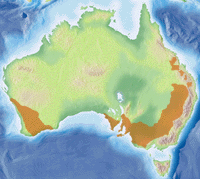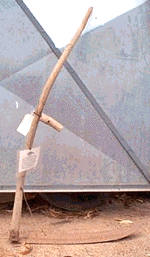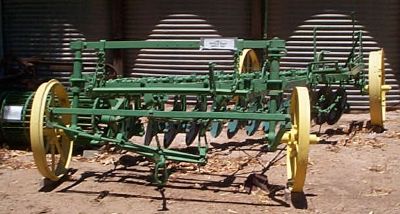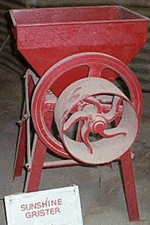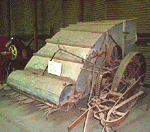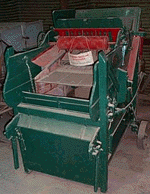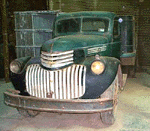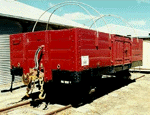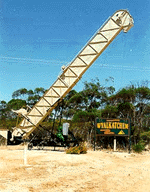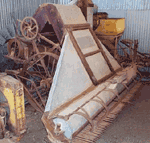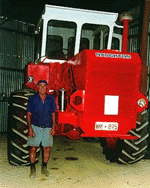The Western Australian Wheat Belt - Crop farming in Western Australia
from the collection of the Wyalkatchem C.B.H Agricultural Museum, W.A. | |||||||||||||
Did you know that the most widely eaten food on Earth is a type of grass? Wheat and other grain crops such as rice, oats and barley are all part of the grass family. Wheat is one of the most important food sources for humans; for thousands of years we have grown, milled and baked wheat, transforming it into countless types of foods. Can you imagine going through even one day without bread, pasta or biscuits? Wheat can only grow where there is dependable rainfall, fertile soil and where the land is quite flat so that farm machinery can be used without difficulty. In Australia, most of the country is either too wet or too dry, but there are certain regions which are suitable for wheat growth. These form an area that is known as the Wheat Belt or the Wheat and Sheep Zone - indicated by the orange sections on the map below. In Australia, wheat is sown in the autumn, grown through winter and then harvested in spring. This might seem strange, but there is a good reason for it; rain is very important for the growth of the crop and our rainfall is most reliable during the winter months.
It has been many hundreds of years since wheat farming was done entirely by hand. Since the Industrial Revolution, over 250 years ago, many machines have been developed to carry out specific farming tasks. Separate machines are used to plough the soil, sow the seed, spray pesticides and fertilisers on the growing crop and then to harvest the wheat. Trucks and trains are used to transport the wheat from the fields to mechanised factories where it is milled and turned into flour. The use of all these machines means that we can now grow much more wheat than we need - Australia exports around 80% of the wheat produced by our farmers. Most soils used for wheat crops need to be fertilised - this means that chemicals are added to the soil so that the growing plants have all the nutrients they need. These fertilisers help the wheat to grow, but they can also damage soils and water. One alternative to chemical fertilisers is crop rotation, a technique developed during the Agricultural Revolution, over a thousand years ago. People realised that growing crops in the same field year after year exhausts the soil - stripping it of nutrients so that eventually nothing can be grown successfully. Using crop rotation, crops like lupins and clover are grown every second and third year. These plants put nutrients back into the soil and they can also be used to feed sheep and cattle. Wheat was introduced to Australia with the arrival of the first europeans, just over 200 years ago. Since then, we have cleared much bushland to make fields where wheat and other crops can be grown. This has dramatically changed Australia’s landscape. In Western Australia, nearly 18 million hectares previously covered by native trees and plants has been cleared for agricultural use. (A hectare is about the same size as a soccer field.) When land is cleared of native vegetation and used for crops, water rises up through the earth. As it rises, the water dissolves salt held within the soil and brings it to the surface. This causes a problem known as salinity - where very high levels of salt are in the soil, making it impossible to grow any crops or other plants. Sometimes the salinity problem can be so severe that it is irreversible. Salinity is a problem throughout Australia, but it is most serious in Western Australia. The government, communities, research centres and farmers are working together to manage the problem. Many strategies are being developed, including the integration of new tree-crop farming systems and different kinds of water management. If these are successful, we may be able to maintain a balance where our use of the land has minimal impact on the environment.
|
| ||||||||||||

